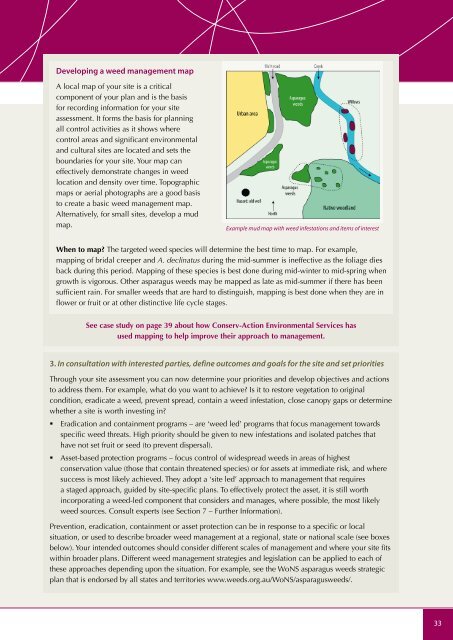Asparagus weeds - Weeds Australia
Asparagus weeds - Weeds Australia
Asparagus weeds - Weeds Australia
- No tags were found...
You also want an ePaper? Increase the reach of your titles
YUMPU automatically turns print PDFs into web optimized ePapers that Google loves.
Developing a weed management mapA local map of your site is a criticalcomponent of your plan and is the basisfor recording information for your siteassessment. It forms the basis for planningall control activities as it shows wherecontrol areas and significant environmentaland cultural sites are located and sets theboundaries for your site. Your map caneffectively demonstrate changes in weedlocation and density over time. Topographicmaps or aerial photographs are a good basisto create a basic weed management map.Alternatively, for small sites, develop a mudmap.Example mud map with weed infestations and items of interestWhen to map? The targeted weed species will determine the best time to map. For example,mapping of bridal creeper and A. declinatus during the mid-summer is ineffective as the foliage diesback during this period. Mapping of these species is best done during mid-winter to mid-spring whengrowth is vigorous. Other asparagus <strong>weeds</strong> may be mapped as late as mid-summer if there has beensufficient rain. For smaller <strong>weeds</strong> that are hard to distinguish, mapping is best done when they are inflower or fruit or at other distinctive life cycle stages.See case study on page 39 about how Conserv-Action Environmental Services hasused mapping to help improve their approach to management.3. In consultation with interested parties, define outcomes and goals for the site and set prioritiesThrough your site assessment you can now determine your priorities and develop objectives and actionsto address them. For example, what do you want to achieve? Is it to restore vegetation to originalcondition, eradicate a weed, prevent spread, contain a weed infestation, close canopy gaps or determinewhether a site is worth investing in?• Eradication and containment programs – are ‘weed led’ programs that focus management towardsspecific weed threats. High priority should be given to new infestations and isolated patches thathave not set fruit or seed (to prevent dispersal).• Asset-based protection programs – focus control of widespread <strong>weeds</strong> in areas of highestconservation value (those that contain threatened species) or for assets at immediate risk, and wheresuccess is most likely achieved. They adopt a ‘site led’ approach to management that requiresa staged approach, guided by site-specific plans. To effectively protect the asset, it is still worthincorporating a weed-led component that considers and manages, where possible, the most likelyweed sources. Consult experts (see Section 7 – Further Information).Prevention, eradication, containment or asset protection can be in response to a specific or localsituation, or used to describe broader weed management at a regional, state or national scale (see boxesbelow). Your intended outcomes should consider different scales of management and where your site fitswithin broader plans. Different weed management strategies and legislation can be applied to each ofthese approaches depending upon the situation. For example, see the WoNS asparagus <strong>weeds</strong> strategicplan that is endorsed by all states and territories www.<strong>weeds</strong>.org.au/WoNS/asparagus<strong>weeds</strong>/.33
















